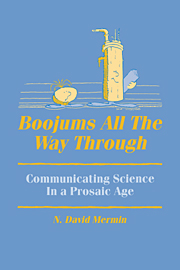Book contents
- Frontmatter
- Contents
- Preface
- I Reflections on the pursuit of physics
- 1 E pluribus boojum: The physicist as neologist
- 2 Commencement address, St. Johns College, Santa Fe, May 18, 1986
- 3 “One of the great physicists … and great characters”
- 4 My life with Landau
- 5 What's wrong with this Lagrangean?
- 6 What's wrong with this library?
- 7 What's wrong with this prose?
- 8 What's wrong with these equations?
- 9 What's wrong with these prizes?
- II The quantum theory
- III Relativity
- IV Mathematical musings
1 - E pluribus boojum: The physicist as neologist
Published online by Cambridge University Press: 02 December 2009
- Frontmatter
- Contents
- Preface
- I Reflections on the pursuit of physics
- 1 E pluribus boojum: The physicist as neologist
- 2 Commencement address, St. Johns College, Santa Fe, May 18, 1986
- 3 “One of the great physicists … and great characters”
- 4 My life with Landau
- 5 What's wrong with this Lagrangean?
- 6 What's wrong with this library?
- 7 What's wrong with this prose?
- 8 What's wrong with these equations?
- 9 What's wrong with these prizes?
- II The quantum theory
- III Relativity
- IV Mathematical musings
Summary
I know the exact moment when I decided to make the word “boojum” an internationally accepted scientific term. I was just back from a symposium at the University of Sussex near Brighton, honoring the discovery of the superfluid phases of liquid helium-3, by my Cornell colleagues Doug Osheroff, Bob Richardson, and Dave Lee. The Sussex Symposium took place during the drought of 1976. The Sussex downs looked like brown Southern California hills. For five of the hottest days England has endured, physicists from all over the world met in Sussex to talk about what happens at the very lowest temperatures ever attained.
Superfluid helium-3 is an anisotropic liquid. The anisotropy is particularly pronounced in the phase known as He-A. A family of lines weaves through the liquid He-A which can be twisted, bent or splayed, but never obliterated by stirring or otherwise disturbing the liquid.
Several of us at the Sussex Symposium had been thinking about how the lines in He-A would arrange themselves in a spherical drop of the liquid. The most symmetrical pattern might appear to have lines radiating outward from the center of the drop, like the quills of a (spherical) hedgehog (Fig. 1). There is an elegant topological argument, however, that such a pattern cannot be produced without at the same time producing a pair of vortex lines connecting the point of convergence of the anisotropy lines to points on the surface of the drop (Fig. 2).
- Type
- Chapter
- Information
- Boojums All the Way throughCommunicating Science in a Prosaic Age, pp. 3 - 25Publisher: Cambridge University PressPrint publication year: 1990

